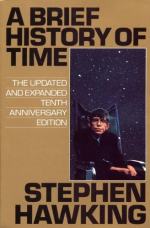
|
| Name: _________________________ | Period: ___________________ |
This test consists of 15 multiple choice questions and 5 short answer questions.
Multiple Choice Questions
1. What question is among the unanswerable questions children ask, according to the Introduction?
(a) Why is there a universe?
(b) Why does time only go in one direction?
(c) Why are we here?
(d) What happens when we die?
2. What is the name for the limit that states the smallest mass a star can have in order for it to produce a black hole?
(a) Subrahmanyan limit.
(b) Torontareian limit.
(c) Rustinmaliyan limit.
(d) Chandrasekhar limit.
3. As an observer's velocity comes close to the speed of light, the observer's mass does what?
(a) Decreases to almost nothing.
(b) Increases to almost infinity.
(c) Stays the same.
(d) Covers more space.
4. If we created a black hole by exploding a very large hydrogen bomb what would happen?
(a) The sun would be destroyed.
(b) The entire solar system would be destroyed.
(c) The inner solar system would be destroyed.
(d) The entire world would be destroyed.
5. How close is the closest star, other than the sun, to earth?
(a) About 5 light years distant.
(b) About 4 light years distant.
(c) About 5 light years distant.
(d) About 3 light years distant.
6. What force is so strong in a black hole that nothing can escape?
(a) Electricity.
(b) Magnetism.
(c) Gravity.
(d) Force.
7. To observe black holes you must observe what?
(a) Their distance from the nearest star.
(b) Their mass.
(c) Their cause.
(d) Their effects.
8. Hawking is what type of physicist?
(a) Particle.
(b) Theoretical.
(c) Micro.
(d) Astro.
9. The theory of quantum mechanics best describes what world?
(a) The small world of atoms.
(b) The small world of particles.
(c) The small world of molecules.
(d) The small world of sub-atomic particles.
10. Groups of atoms create what?
(a) Empty space.
(b) Matter.
(c) Protons.
(d) Electrons.
11. A black hole has zero what?
(a) Expansion.
(b) Curvature.
(c) Volume and surface area.
(d) Mass.
12. Stephen Hawking has what disease?
(a) AIDS.
(b) Cancer.
(c) Lou Gehrig's disease.
(d) Ancel Hoffman disease.
13. In order to explain how black holes become a big bang, Hawking needs to include what?
(a) The theory of relativity.
(b) The theory of everything.
(c) Particle physics.
(d) Quantum mechanics.
14. The disease Stephen Hawking has affects what?
(a) His body.
(b) His mind.
(c) His ability to reason.
(d) His emotions.
15. What is one of the colors of quarks?
(a) Purple.
(b) White.
(c) Yellow.
(d) Red.
Short Answer Questions
1. Hawking co-authored a paper in what year that explains the big bang theory?
2. As a consequence of quantum mechanics, waves sometimes behave like what?
3. The only constant in the universe is what?
4. Philosophers try to understand the universe using what method?
5. For satellites orbiting the earth, time does what in relation to the ground of the earth?
|
This section contains 428 words (approx. 2 pages at 300 words per page) |

|




